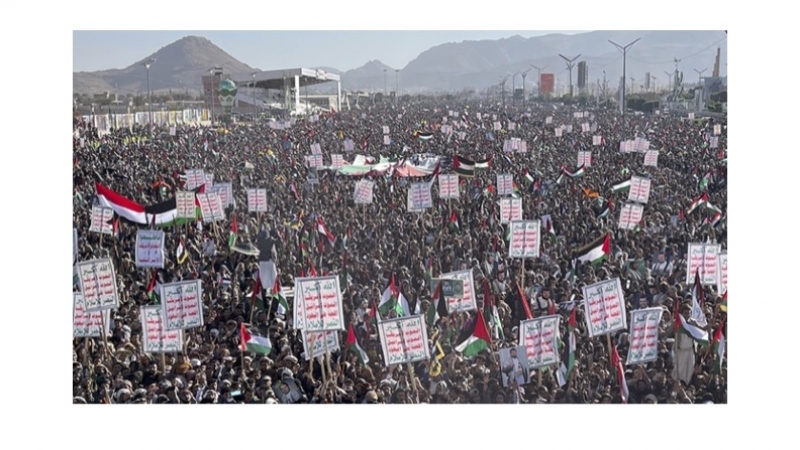Ansarallah’s Daring Challenge To US Imperialism And Zionist Barbarism
Empowering Weak & OppressedOmar Ahmed
Dhu al-Qa'dah 03, 1446 2025-05-01
News & Analysis
by Omar Ahmed (News & Analysis, Crescent International Vol. 55, No. 3, Dhu al-Qa'dah, 1446)

In a dramatic escalation of regional resistance, Yemen’s Ansarallah-allied armed forces have intensified military operations against the zionist entity and its western backers. This surge includes a rare missile strike on northern occupied Palestine and a renewed maritime blockade in the Red Sea, underscoring Sana‘a’s unwavering commitment to supporting Gaza amidst ongoing aggression.
Expanding the Front: Ansarallah Targets Northern Occupied Territories
On April 23, Ansarallah-aligned forces launched a ballistic missile at northern areas of the zionist entity, marking a significant expansion of their operational reach. The Israeli military reported intercepting the missile, with sirens sounding in regions such as Haifa and Krayot.
This action represents a notable shift, as Ansarallah’s previous strikes targeted primarily southern regions like Eilat. While Ansarallah did not immediately claim responsibility, the attack coincided with their announcement of downing another American MQ-9 Reaper drone over Yemen’s Hajjah governorate using a domestically produced missile. These developments highlight Yemen’s growing capabilities and resolve in confronting both the occupation state and its allies.
In March, in response to the zionist entity’s continued blockade and genocidal war on Gaza, Ansarallah reinstated its ban on Israeli-linked vessels traversing key maritime routes, including the Red Sea, Bab al-Mandab Strait, and the Gulf of Aden.
In a statement, the Yemeni military explained: “This prohibition will remain until crossings into Gaza are reopened and humanitarian aid, including essential food and medicine, is permitted entry.”
As such, any ship associated with the occupation state, or heading to its ports, will be treated as a legitimate target. Over the past few days, maritime tracking services have reported several vessels re-routing around the Cape of Good Hope to avoid the Red Sea, indicating the deterrent effect of Ansarallah’s stance.
US Aggression and Escalation
In parallel with Ansarallah’s increased operations, the US has intensified its airstrikes on Yemen under the guise of “protecting freedom of navigation.” On April 21, American warplanes launched attacks on multiple sites in Sanaa and Hudaydah, purportedly targeting missile launch platforms and drone facilities.
However, civilian casualties were reported, prompting accusations of collective punishment against a population already suffering under a humanitarian blockade. There is even growing speculation that the US may launch a ground offensive, targeting Ansarallah positions in the Al-Tahita district in southern Al-Hudaydah Governorate, western Yemen.
Ansarallah’s leadership responded by vowing to expand its operations, warning that US bases and military assets in the region are within range of its drones and missiles. This statement was reinforced by footage released through affiliated media channels showing long-range drones being prepped for launch, accompanied by chants of “Death to America, Death to Israel.”
Regional Reverberations and Strategic Shifts
The Ansarallah movement’s actions are resonating across West Asia. In Iraq and Syria, resistance groups have issued statements of solidarity and hinted at coordinated responses to the occupation regime’s ongoing atrocities in Gaza and the West Bank. Even in Jordan, despite official silence, grassroots movements have voiced support for Ansarallah’s defiance.
Indeed, the western-backed and propped Hashemite Kingdom has even moved to ban the Muslim Brotherhood outright, following the recent crackdown. A group believed to be affiliated with the movement was found to be “producing missiles and drones as part of an alleged plot to incite unrest within Jordan.”
This convergence of resistance actors is unsettling for Washington and Tel Aviv. The broader “Axis of Resistance,” long derided in the western media, is now increasingly seen as a credible military and ideological challenge to American hegemony in West Asia.
Symbolism and Strategy
Ansarallah’s recent actions are not just tactical but deeply symbolic. The strike on northern occupied Palestine signals the erosion of the occupation state’s perceived invulnerability, while the maritime campaign reclaims control over one of the world’s most strategic chokepoints.
In both cases, the Sanaa government is projecting power far beyond Yemen’s borders, countering decades of humiliation inflicted by western-backed regimes such as those in the Arabian Peninsula and their Bedouin allies in the Emirates.
As the war on Gaza grinds on with no let-up in the brutality inflicted by the zionist entity, Ansarallah’s challenge becomes more than a Yemeni cause—it becomes a rallying cry across the region.
In keeping with Yemen’s public and official support for Palestine, the Al-Aqsa Support Committee on Friday April 25 called on the Yemeni people to stage a massive two-million-strong march in Sabeen Square, Sanaa, and across other governorates, under the slogan: “Steadfast with Gaza... Defying America and Its Crimes.”
Whether on land, sea, or in the air, the message is clear: the era of unilateral domination is fading, and the forces of resistance are no longer content to fight in the shadows.




